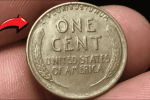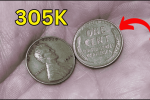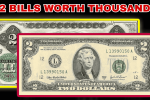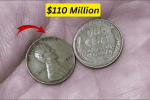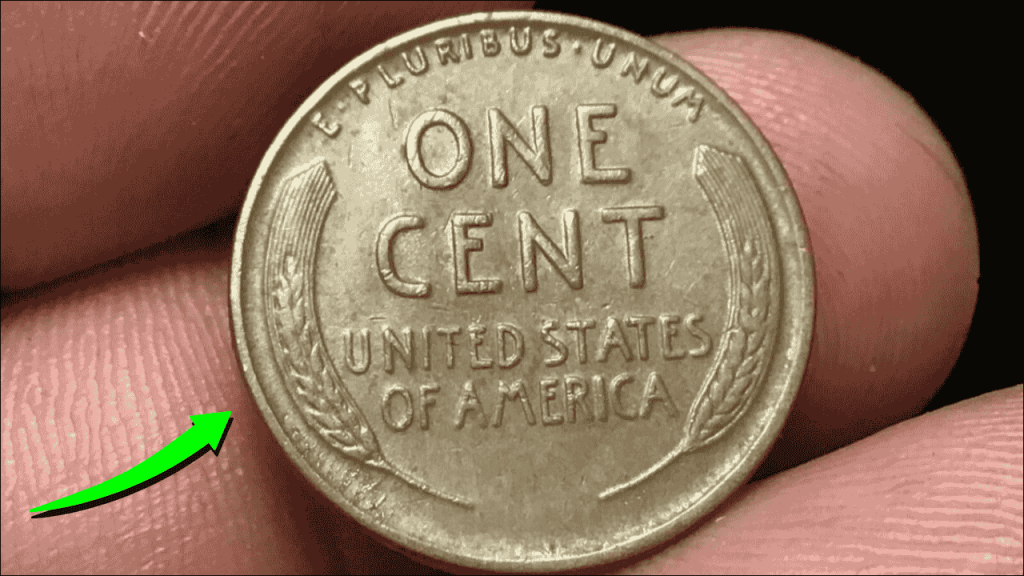
In the vast sea of coins passing through our hands daily, few people pause to examine the humble penny. Yet, hidden among these overlooked copper discs could be a numismatic treasure worth hundreds of thousands of dollars. The Lincoln Wheat Penny, minted from 1909 to 1958, has become one of America’s most sought-after collectibles, with certain rare specimens commanding prices up to $510,000. Most astonishingly, some of these valuable pennies may still be circulating today, tucked away in spare change jars, forgotten collections, or perhaps even in the handful of coins you received from your last transaction.
The Historical Significance of the Lincoln Wheat Penny
The story of the Lincoln Wheat Penny begins in 1909 during the centennial celebration of Abraham Lincoln’s birth. This coin marked a pivotal moment in American numismatic history as the first regular-issue U.S. coin to feature the portrait of an actual person rather than the allegorical Lady Liberty that had adorned American coinage for more than a century.
| Historical Milestone | Significance |
|---|---|
| First Person on U.S. Coin | Broke tradition of symbolic figures on American currency |
| Designer | Victor David Brenner (whose initials VDB appeared on early 1909 issues) |
| Production Period | 1909-1958 (nearly 50 years of continuous production) |
| Reverse Design | Two wheat stalks flanking denomination and country name |
| Replacement | Lincoln Memorial design introduced in 1959 |
The distinctive wheat stalk reverse design, framing the words “ONE CENT” and “UNITED STATES OF AMERICA,” gave these coins their enduring nickname—”Wheat Pennies” or “Wheaties.” For nearly half a century, these coins were a fixture in American commerce, passing through countless hands during some of the nation’s most transformative periods: two World Wars, the Great Depression, and the beginning of the Cold War era.
The $510,000 Penny: The 1943 Copper Anomaly
The most valuable and legendary of all Wheat Pennies emerged during World War II, when the United States was channeling resources toward the war effort. In 1943, copper was designated as a strategic material vital for military equipment and ammunition production. The U.S. Mint responded by switching to zinc-coated steel for penny production that year, creating distinctive silvery pennies that stand out in any collection.
However, a minuscule number of copper planchets (the metal discs used to create coins) from 1942 production were accidentally left in the presses. When these copper blanks were struck with the 1943 dies, they created what would become some of the most valuable errors in American coinage history.
| 1943 Penny Varieties | Composition | Approximate Population | Current Value Range |
|---|---|---|---|
| Standard 1943 Steel Pennies | Zinc-coated steel | 1 billion+ | $0.20-$10 (circulated) |
| 1943 Bronze/Copper Philadelphia | Copper (error) | 10-15 known | $100,000-$510,000 |
| 1943-S Bronze/Copper (San Francisco) | Copper (error) | 6 known | $150,000-$500,000 |
| 1943-D Bronze/Copper (Denver) | Copper (error) | 1 confirmed | $1,000,000+ |
The 1943 copper cents are extremely rare, with only about 20-30 authenticated examples known to exist across all three mints. Their incredible scarcity combined with their historical significance as wartime production errors has driven their value to extraordinary heights. Well-preserved specimens have sold for up to $510,000 at auction, and it’s believed the single confirmed 1943-D copper cent could be worth over $1 million if it ever came to market.
Other Highly Valuable Wheat Pennies to Look For
While the 1943 copper penny represents the ultimate prize for wheat cent collectors, several other varieties command impressive prices and may still be found in circulation or in old collections.
| Year & Mint Mark | Key Characteristics | Approximate Value (Good to Uncirculated) |
|---|---|---|
| 1909-S VDB | San Francisco mint, designer’s initials on reverse | $750-$50,000+ |
| 1914-D | Denver mint, low mintage | $250-$10,000+ |
| 1922 Plain (No D) | Denver mint mark missing due to die error | $500-$25,000+ |
| 1931-S | San Francisco mint, low mintage (866,000) | $100-$2,000+ |
| 1944 Steel | Wrong planchet error (should be copper) | $30,000-$125,000+ |
| 1955 Double Die Obverse | Dramatic doubling on date and lettering | $1,000-$17,000+ |
The Story Behind the 1909-S VDB
The 1909-S VDB penny holds special significance in American numismatics. When designer Victor David Brenner placed his initials “VDB” on the reverse of the coin, public controversy erupted over their prominence. The Mint quickly removed the initials, but not before 484,000 coins with the initials had been produced at the San Francisco Mint. Today, these coins are highly prized by collectors, with well-preserved specimens commanding tens of thousands of dollars.
The Elusive 1922 “Plain” Penny
In 1922, pennies were only produced at the Denver Mint. However, due to a worn die that failed to imprint the “D” mint mark, a small number of these coins appear to have no mint mark at all. These “plain” 1922 pennies are highly sought after, with values ranging from a few hundred dollars for heavily circulated examples to tens of thousands for pristine specimens.
How to Identify Potentially Valuable Wheat Pennies
For those hoping to discover valuable wheat pennies in circulation or in inherited collections, here’s a systematic approach to identifying potential treasures:
Step 1: Check the Date and Mint Mark
The first and most crucial characteristic to examine is the date, located on the obverse (front) of the coin beneath Lincoln’s portrait. Pay special attention to the years highlighted in the table above: 1909, 1914, 1922, 1931, 1943, 1944, and 1955.
The mint mark, if present, appears below the date. Look for a small letter:
- No letter: Philadelphia Mint
- “D”: Denver Mint
- “S”: San Francisco Mint
Step 2: Verify the Composition of 1943 Pennies
If you find a 1943 penny that appears copper in color rather than silvery steel, you may have something extraordinary. Here’s how to test it:
| Test Method | What It Tells You |
|---|---|
| Magnet Test | Steel pennies (common) stick to magnet; copper pennies (rare) do not |
| Weight Test | Copper: approximately 3.11 grams; Steel: approximately 2.7 grams |
| Visual Inspection | Copper: warm brown tone; Steel: silvery color (possibly with rust) |
Be aware that counterfeiters sometimes plate steel 1943 pennies with copper or alter the date on 1948 pennies. An authentic 1943 copper penny should not be magnetic and should weigh approximately 3.11 grams.
Step 3: Look for Error Features on Key Dates
For certain years, specific errors create additional value:
- 1955 Double Die: Look for obvious doubling on the date, “LIBERTY,” and “IN GOD WE TRUST”
- 1922 Plain: Check that there is genuinely no mint mark (not just worn or faint)
- 1909-S VDB: Verify the presence of “VDB” on the reverse at the bottom rim
Step 4: Assess Condition
Coin condition dramatically affects value. Numismatists use a standardized grading scale:
| Grade | Abbreviation | Visual Characteristics |
|---|---|---|
| Good | G-4 | Heavy wear, major details visible but worn |
| Very Good | VG-8 | Moderate wear, all lettering visible |
| Fine | F-12 | Light wear, some details in Lincoln’s hair |
| Very Fine | VF-20/30 | Minor wear, most hair details visible |
| Extremely Fine | EF/XF-40/45 | Slight wear on highest points |
| About Uncirculated | AU-50/58 | Minimal wear, most original luster |
| Mint State | MS-60 to MS-70 | No wear, original mint luster (with varying quality) |
What To Do If You Find a Valuable Penny
If you believe you’ve discovered a potentially valuable wheat penny, follow these important steps to protect both the coin and its value:
- Proper Handling: Hold the coin only by its edges to prevent oils and acids from your fingers from damaging the surface.
- Avoid Cleaning: Never clean a potentially valuable coin. The natural patina that develops over decades is valued by collectors, and cleaning can severely reduce a coin’s worth.
- Safe Storage: Place the coin in a protective holder—preferably a non-PVC, inert flip or capsule designed for coin storage.
- Professional Authentication: For coins potentially worth more than $100, consider having the coin authenticated and graded by a reputable service such as Professional Coin Grading Service (PCGS) or Numismatic Guaranty Corporation (NGC).
| Authentication Service | What They Provide | Approximate Cost |
|---|---|---|
| PCGS/NGC Grading | Authentication, condition grade, tamper-proof holder | $20-$50+ depending on value |
| Dealer Appraisal | Informal assessment of potential value | Often free (if considering purchase) |
| Coin Show Evaluation | Expert opinions, potential for immediate sale | Varies (admission fee to show) |
Why Rare Wheat Pennies Might Still Be in Circulation
Unlike many valuable collectibles that were quickly recognized and preserved, certain rare pennies have remained in circulation for several reasons:
- Visually Similar: Many valuable wheat pennies look similar to common ones to the untrained eye
- Perceived Low Value: People are more likely to overlook pennies than higher-denomination coins
- Vast Numbers: Billions of wheat pennies were produced, making detection of rare specimens challenging
- Limited Awareness: Many people simply aren’t aware that certain pennies could be worth small fortunes
These factors combine to create the tantalizing possibility that extremely valuable coins could still be passing through everyday transactions, waiting for an observant individual to discover them.
The Legacy and Cultural Impact of Wheat Pennies
The Lincoln Wheat Penny represents more than just a potential financial windfall; it embodies a tangible connection to American history. These coins passed through the hands of multiple generations during transformative times in American life, from the early automobile era through two World Wars and into the beginning of the Space Age.
For many collectors, wheat pennies provided an entry point into the fascinating world of numismatics. Their relative abundance, historical significance, and the accessible thrill of potentially finding valuable specimens have made wheat penny collecting one of America’s most popular numismatic pursuits.
The quest for valuable wheat pennies embodies an appealing democratic notion: that extraordinary value might be hiding in plain sight, accessible to anyone with the knowledge and observational skills to recognize it. This accessibility has helped coin collecting remain one of America’s most enduring and popular hobbies.
Conclusion
The Lincoln Wheat Penny’s journey from everyday currency to highly valued collectible demonstrates how ordinary objects can transform into extraordinary treasures with the passage of time. While finding a $510,000 penny remains a statistical long shot, these coins continue to emerge from old collections, forgotten coin jars, and occasionally even circulation.
This hunt for numismatic treasure adds an element of excitement to our interaction with everyday currency. The next time you receive change from a purchase or stumble upon an old jar of coins, take a moment to examine those pennies with a more careful eye. Among those humble copper discs could be a small piece of American history worth far more than its one-cent face value—perhaps even a coin worth hundreds of thousands of dollars.
Frequently Asked Questions
How can I tell if my 1943 penny is copper instead of steel?
Try the magnet test—a steel penny will stick to a magnet, while a genuine copper penny will not. Also, copper pennies have a distinctive warm brown color compared to the silvery appearance of steel cents.
Will cleaning my old wheat pennies increase their value?
No—cleaning almost always decreases a coin’s value significantly. Collectors prefer the natural patina that develops over time, and cleaning can remove this desirable characteristic and damage the coin’s surface.
How many 1943 copper pennies are known to exist?
Approximately 20-30 authentic 1943 copper pennies are known across all three mints (Philadelphia, Denver, and San Francisco), with only one confirmed from the Denver Mint.
What makes the 1955 “Double Die” penny valuable?
This error occurred when the die used to strike the coin was misaligned during the hubbing process, creating a dramatic doubling effect visible on the date and inscriptions on the obverse side.
Could wheat pennies become even more valuable in the future?
Yes, as these coins become increasingly scarce and collector interest continues, values for rare and high-grade specimens will likely continue to appreciate over time.
Should I sell a valuable penny if I find one, or hold onto it?
For extremely valuable finds like a 1943 copper penny, consulting with multiple coin experts before making any decision is wise. Market conditions fluctuate, and proper authentication is essential before considering any sale.

Isabell Johnson is a passionate writer known for captivating stories that blend imagination and reality. Inspired by travel, history, and everyday moments, She crafts narratives that resonate deeply with readers.
